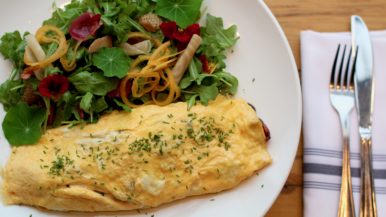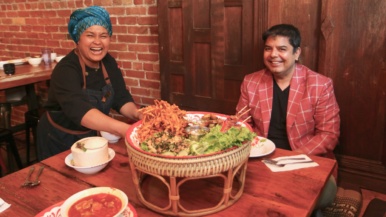Why the lobster at Rodney’s Oyster House is one of Toronto’s essential dishes
Toronto’s a city of many neighbourhoods and many nationalities, so finding that one oh-so-Toronto dish is an impossible task. We’re asking some of the city’s top food folks about their favourite T.O. meals

Rodney Clark, owner of the eponymous oyster house on King West, could be called Toronto’s mayor of mollusks. Ask any chef who has the best oysters in town, and there’s a very good chance Clark will get a shout-out. He’s been shucking bivalves for the past three decades, serving them with a side of his impish East-Coast charm.
Chef Mark McEwan has been a fan of Rodney’s Oyster House since 1990. Back then, after wrapping up a long shift at North 44, he and his chef de cuisine would head to Rodney’s (back when it was located at Adelaide and Jarvis) and indulge in oysters, boiled lobster and a few pints. Each of these nights would be capped off with an order of the chocolate mousse. “We were so buttoned-down at North 44, whereas Rodney always had an irreverent way of doing business—he’s a fun, eccentric loose cannon,” says Mark, slurping down a Sand Dune oyster. “The original location was almost like a speakeasy where people could let loose—it was just a classic oyster house.”
Rodney’s Oyster House’s Lobster Boiled & Cracked
469 King St. W., 416-363-8105, rodneysoysterhouse.com/toronto

In the ’80s, Rodney’s was one of the highlights of a conservative city, one that still went by “Toronto the Good.” According to Clark, “people needed to have the silver pickle forks taken out of their asses” and that started with champagne and beer. “We were the top pourer of Dom for a while, and the No. 2 pourer of Keith’s, which we used to have to special-order back then,” says Clark, before saying how much he misses the rubberized floor at the original location. “The glasses would just bounce back into people’s hands!”
McEwan will argue it’s not just the flowing bubbles that kept the customers coming back, but the quality of the seafood, which he says is unparalleled in the city. “Rodney was the first to have his own supply side, his own farms; he really has amazing stuff,” says Mark, who buys wholesale seafood for his own restaurants from Rodney’s.

Clark got his start in the seafood business when he was 37. Before that, he was a commercial artist and the fish thing was just a side job where he would shuck oysters in backyards and cater lobster boils. As the fish shtick wasn’t his main form of employment, he first asked to be paid for these gigs in wine. (He would later use some of the more expensive ones to pay for court fees when his business partnership dissolved.) His favourite bottle of wine was a gift from a member of the Eaton clan. He recalls that in 1986 there was a nationwide shellfish ban, but he still had access to contraband bivalves. “Mrs. Eaton called me around Christmas and asked me if I had any oysters,” says Clark. “It was illegal to sell oysters then… but of course I sold them to her!”


Clark has always been well connected—even as a dilettante oyster shucker, he had friends in high places. If you look at the walls decorated with signed shells, it’s evident the P.E.I. native has a legion of famous friends: everyone from members of the Hell’s Angels to red-carpet regulars.
After the two demolish a dozen oysters, McEwan begins to prepare for the lobster course. “I would always get rid of the clarified butter it comes with and make my own beurre fondue with butter, green Tabasco, lemon and some of Rodney’s White Boy Sauce,” he says while whisking the concoction into an emulsion. “The not-so-hot sauce is perfect for me because I can’t tolerate too much spice—I start to perspire.”


Rodney’s lobsters are perfectly cooked. “You see how the roe is still black? That’s how you know it’s not over done,” says Clark. “By around 7 or 8 p.m., we could sell the stock we boil them in for soup.” Of course, Rodney’s doesn’t just chuck the crustaceans into boiling water; they’re cooked in a mixture of mirepoix, beer and sea salt.


McEwan’s trip down memory lane concludes with an order of the chocolate mousse, which hasn’t changed in 30 years. The secret, according to Clark, is to beat the mousse by hand so that the texture—not a timer—tells you when it’s done. Just as the meal wraps up, Clark asks one of his staff if the new shipment of scallops has come in. Turns out it has, so the two finish with a few raw scallops, fresh from the can (they’re shipped that way so they don’t get flattened in transit). “It’s dessert after dessert,” says Clark.







